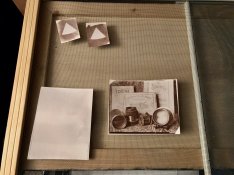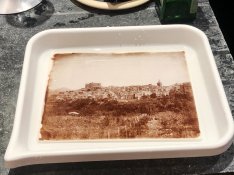NedL
Subscriber
A rainy weekend day when I’d like to print makes me think about this process sometimes. I haven’t tried it yet, and don’t know anyone who has used it successfully. I know several people who tried and said the paper turned black all over in the developer, maybe because of the paper used or maybe because it needs very short exposures compared to printing out. The process is supposed to work even on the darkest rainy days. I’m posting this here in case anyone is interested in reading about it.
Alan Greene in his book Primitive Photography* discusses how developed out salted paper prints had a reputation for being neutral or colder toned, but he disputes this and says they can have a warm tone indistinguishable from being printed out. He also correctly points out that they are just as “historically authentic” as more typical printed out salt prints. Greene says that sunny days are for making photographs and rainy days are for printing. There's something very appealing about that on a day like today.
( The following paragraph is summarized from The Encyclopedia of Nineteenth-Century Photography )
In the early 1850’s, the French calotypist Louis Désiré Blanquart-Evrard was making developed out prints at his studio in Lille, France. The English calotypist Thomas Sutton sent negatives to Blanquart-Evrard for printing, and offered to no avail to pay to learn the details of the process. In 1855, Sutton published a book A New Method of Printing Positive Photographs, by Which Permanent and Artistic Results May Be Uniformly Obtained, which described his developed-out process using whey. Soon afterward, Sutton decided to open his own printing studio, and again contacted Blanquart-Evrard, this time being invited to Lille to learn the details of the printing there. After Blanquart-Evrard’s studio failed, he and Sutton opened a new printing facility in Jersey, which only lasted a couple years. Presumably the prints made at this facility used developing out methods.
Sutton was the editor of Photographic Notes. I’ve attached to this post a description of developed-out plain salted paper prints that he wrote and published in Photographic Notes in 1860. I’ve also attached an excerpt from the 1856 book On the various methods of printing photographic pictures upon paper by Robert Howlett, which describes Sutton’s whey process and also a process by Thomas Hardwich which used a gelatin binder. Hardwich also wrote about developed out printing in his 1857 book A manual of photographic chemistry: including the practice of the collodion process.
So, between the two attached files, there are instructions for plain salt, salt with gelatin, and whey. For anyone who makes salted paper prints, it is worth reading the note at the end of Sutton’s whey process instructions for removing hypo:
Many of Sutton’s prints still survive in good condition today, as do those of other printers ( like Thomas Rodger ) who practiced long washes.
I suspect like anything else in photography, it would take a lot of practice and experience to learn to print developed-out salted paper well. I would be interested to hear any experience if anyone tries it. Besides Alan Greene, I’m not aware of anyone who currently uses this process.
*Note, Google Books links used in this post don't work the same way in all countries, but you should be able to search for the same works in your country's version Google Books if you are interested.
Alan Greene in his book Primitive Photography* discusses how developed out salted paper prints had a reputation for being neutral or colder toned, but he disputes this and says they can have a warm tone indistinguishable from being printed out. He also correctly points out that they are just as “historically authentic” as more typical printed out salt prints. Greene says that sunny days are for making photographs and rainy days are for printing. There's something very appealing about that on a day like today.
( The following paragraph is summarized from The Encyclopedia of Nineteenth-Century Photography )
In the early 1850’s, the French calotypist Louis Désiré Blanquart-Evrard was making developed out prints at his studio in Lille, France. The English calotypist Thomas Sutton sent negatives to Blanquart-Evrard for printing, and offered to no avail to pay to learn the details of the process. In 1855, Sutton published a book A New Method of Printing Positive Photographs, by Which Permanent and Artistic Results May Be Uniformly Obtained, which described his developed-out process using whey. Soon afterward, Sutton decided to open his own printing studio, and again contacted Blanquart-Evrard, this time being invited to Lille to learn the details of the printing there. After Blanquart-Evrard’s studio failed, he and Sutton opened a new printing facility in Jersey, which only lasted a couple years. Presumably the prints made at this facility used developing out methods.
Sutton was the editor of Photographic Notes. I’ve attached to this post a description of developed-out plain salted paper prints that he wrote and published in Photographic Notes in 1860. I’ve also attached an excerpt from the 1856 book On the various methods of printing photographic pictures upon paper by Robert Howlett, which describes Sutton’s whey process and also a process by Thomas Hardwich which used a gelatin binder. Hardwich also wrote about developed out printing in his 1857 book A manual of photographic chemistry: including the practice of the collodion process.
So, between the two attached files, there are instructions for plain salt, salt with gelatin, and whey. For anyone who makes salted paper prints, it is worth reading the note at the end of Sutton’s whey process instructions for removing hypo:
Every trace of hyposulphite should then be removed, by washing for twenty-four, or even thirty-six hours, in an abundance of water, which must be changed at least a dozen times.
Many of Sutton’s prints still survive in good condition today, as do those of other printers ( like Thomas Rodger ) who practiced long washes.
I suspect like anything else in photography, it would take a lot of practice and experience to learn to print developed-out salted paper well. I would be interested to hear any experience if anyone tries it. Besides Alan Greene, I’m not aware of anyone who currently uses this process.
*Note, Google Books links used in this post don't work the same way in all countries, but you should be able to search for the same works in your country's version Google Books if you are interested.
Attachments
Last edited:








 ) to use a developer on salt prints - the primary aim being to increase its D
) to use a developer on salt prints - the primary aim being to increase its D








